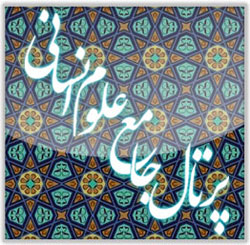Transformation of Shi'a Mourning Rituals from the Buyid Era to the Safavid Period with an Emphasis on the Emergence of Ta'ziyeh and Ritual Symbolism
Keywords:
Shiite mourning rituals, Ta'ziyya, ritual symbolism, Safavid, political legitimacy, religious identityAbstract
Shi'a mourning rituals have undergone a complex trajectory of transformation from the early Islamic centuries to the Safavid period, gradually evolving from simple ceremonies into structured ritual practices with performative and social dimensions. The primary aim of this study is to examine the historical process of the transformation of Shi'a mourning rituals from the Buyid era to the end of the Safavid period, with particular emphasis on the emergence of ta'ziyeh and the development of ritual symbolism within these ceremonies. The central hypothesis of this research is that Shi'a mourning rituals—especially in the form of ta'ziyeh and through the use of symbols such as the ‘alam (banner), nakhl (palm-shaped bier), shamayel (iconic representations), and symbolic costumes—not only reflected the religious sentiments of the Shi'a community, but were also systematically organized and institutionalized by governments, particularly the Safavid state, as instruments for social cohesion, political legitimization, and the reinforcement of religious identity. The methodology of this research is descriptive-analytical and is based on historical documents, library sources, jurisprudential texts, literary works, and accounts by European travel writers. The findings indicate that the foundational elements of legitimizing mourning rituals began to take shape during the Buyid era. However, it was during the Safavid period—with the formal adoption of Shi'ism as the state religion and the state's active support of these rituals—that ta'ziyeh developed into the most prominent form of Shi'a religious performance and emerged as a powerful cultural-political element. Ultimately, this study demonstrates that mourning rituals—especially ta'ziyeh—while preserving traditional elements, extended their functions beyond grief and mourning and played a fundamental role in shaping the social order and the religio-political identity structure of Safavid Iran.
Downloads
References
Akbari, A. (2011). Iran During the Safavid Era. Tehran: Negah Publishing.
Azarfar, M. (1993). The History of Religious Transformations in Iran. Tehran: Soroush Publishing.
Dhahabi, M. i. A. (1987). Tarikh al-Islam. Beirut: Dar al-Kutub al-Ilmiyyah.
Dubois, A. (2015). The Religious Culture of the Safavids. Tehran: University of Tehran Press.
Ebrahimi Dinani, G. (2001). The Brilliance of Avicenna in the Realm of Eastern Philosophy. Tehran: Tarh-e No.
Eskandar Beg, M., & Iraj, A. (2004). The History of Alam-Ara Abbasi. Tehran: Amir Kabir Publishing.
Falasafi, N. (1957). The Life of Shah Abbas I. Tehran: Translation and Publishing Institute.
Francois, B. (1985). Art and Religion in Safavid Iran. Tehran: Islamic Culture and Communication Organization.
Hassanzadeh, S. M. (2003). Analysis of Religious Discourse in Iran. Tehran: Elm Publishing.
Hosseini Tabatabai, M. (2013). Shi'ite Thought in Safavid Iran. Qom: Shi'ism Studies Institute.
Ibn Athir, I. a.-D. (1985). Al-Kamil fi al-Tarikh. Beirut: Dar Sadir.
Ibn Fahl Hilli, A. i. M. (1995). Uddat al-Da'i wa Najah al-Sa'i. Qom: Islamic Publishing Institute.
Ibn Idris, M. i. A. (1991). Al-Sara'ir. Qom: Islamic Publishing Institute.
Ibn Khaldun, A. a.-R. (1988). Al-Muqaddimah. Beirut: Dar al-Fikr.
Ibn Qulawayh, J. i. M. (1997). Kamil al-Ziyarat. Najaf: Dar al-Murtada.
Ibn Tawus, A. i. M. (1994). Al-Malhoof. Beirut: Dar al-Jawad.
Ibn Zohra, A. i. Z. (1990). Ghaniyat al-Nuzoo. Qom: Dar al-Ridha Publications.
Jafarian, R. (2002). The History of Shi'ism in Iran. Qom: Center for Islamic Revolution Documents.
Jalali-Zadeh, Y. (2017). Religious Art in Ta'zieh. Tehran: Culture and Art Research Institute.
Javaheri, A. (2006). Religious History of Iran. Tehran: Markaz Publishing.
Kampfer, E. (1984). Iran at the End of the 17th Century. Tehran: Kharazmi Publishing.
Karbasi, M. (2010). The Culture of Ashura in the Mirror of Art. Tehran: Soroush Publishing.
Kasravi, A. (1946). The History of the Iranian Constitutional Revolution. Tehran: Amir Kabir Publishing.
Khateeb Baghdadi, A. i. A. (2001). Tarikh Baghdad. Beirut: Dar al-Kutub al-Ilmiyyah.
Mas'udi, A. i. H. (1989). Muruj al-Dhahab. Beirut: Dar al-Andalus.
Mirza Muhammad Baqir. (1819). Al-Durr al-Nazim. Tehran: Hijrat Publishing.
Mojtahedi, M. (2011). Cultural Analyses in Islamic Iran. Tehran: Sokhan Publishing.
Muqadasi, M. (1981). Ahsan al-Taqasim fi Ma'rifat al-AqalimPB - Beirut: Dar Sadir.
Naraqi, A. (2012). Sociological Analysis of Religious Rituals in Iran. Tehran: Islamic Culture and Thought Research Institute.
Nazer al-Islam, K. (1983). The Awakening of Iranians. Tehran: Amir Kabir Publishing.
Nouri, M. H. (1988). Al-Lu'lu' wa al-Marjan fi Adab Ahl al-Minbar. Qom: Islamic Book Institute.
Qomi, S. A. (1983). Nafas al-Mahmoom. Qom: Hijrat Publishing.
Rashidi, M. (2019). Transformation of Shi'ite Mourning Rituals. Tehran: University Publishing.
Robinson, L. (2012). Safavid Governance and Religious Policies. Tehran: Amir Kabir Publishing.
Sabt Ibn Jawzi, Y. i. Q. (1993). Tadhkirat al-Khawas. Qom: Maktabat al-Ninawa.
Sharden, J. (1977). Sharden's Travelogue. Tehran: Amir Kabir Publishing.
Sheikh Hurrr Ameli, M. i. H. (1989). Wasa'il al-Shi'ah. Qom: Al-Bayt Institute.
Sheikh Mufid, M. i. M. (1994). Al-Irshad fi Ma'rifat Hujaj Allah 'ala al-Ibad. Qom: Sheikh Mufid Congress.
Sohrabi, F. (1999). Shi'ite Religion During the Safavid Era. Tehran: Scientific and Cultural Publishing.
Tabari, M. i. J. (1987). Tarikh al-Umam wa al-Muluk. Beirut: Dar al-Turath.
Taheri, G. (1997). The Culture of Religious Symbols in Mourning. Tehran: Art Research Institute.
Tavernier, J.-B. (1973). Tavernier's Travelogue. Tehran: Translation and Publishing Institute.
Tizfahm, H. (2003). Social History of Iran During the Safavid Period. Tehran: University Publishing Center.
Yousofi Qaravi, R. (2004). Research on Ashura Rituals. Qom: Bustan-e Ketab.








